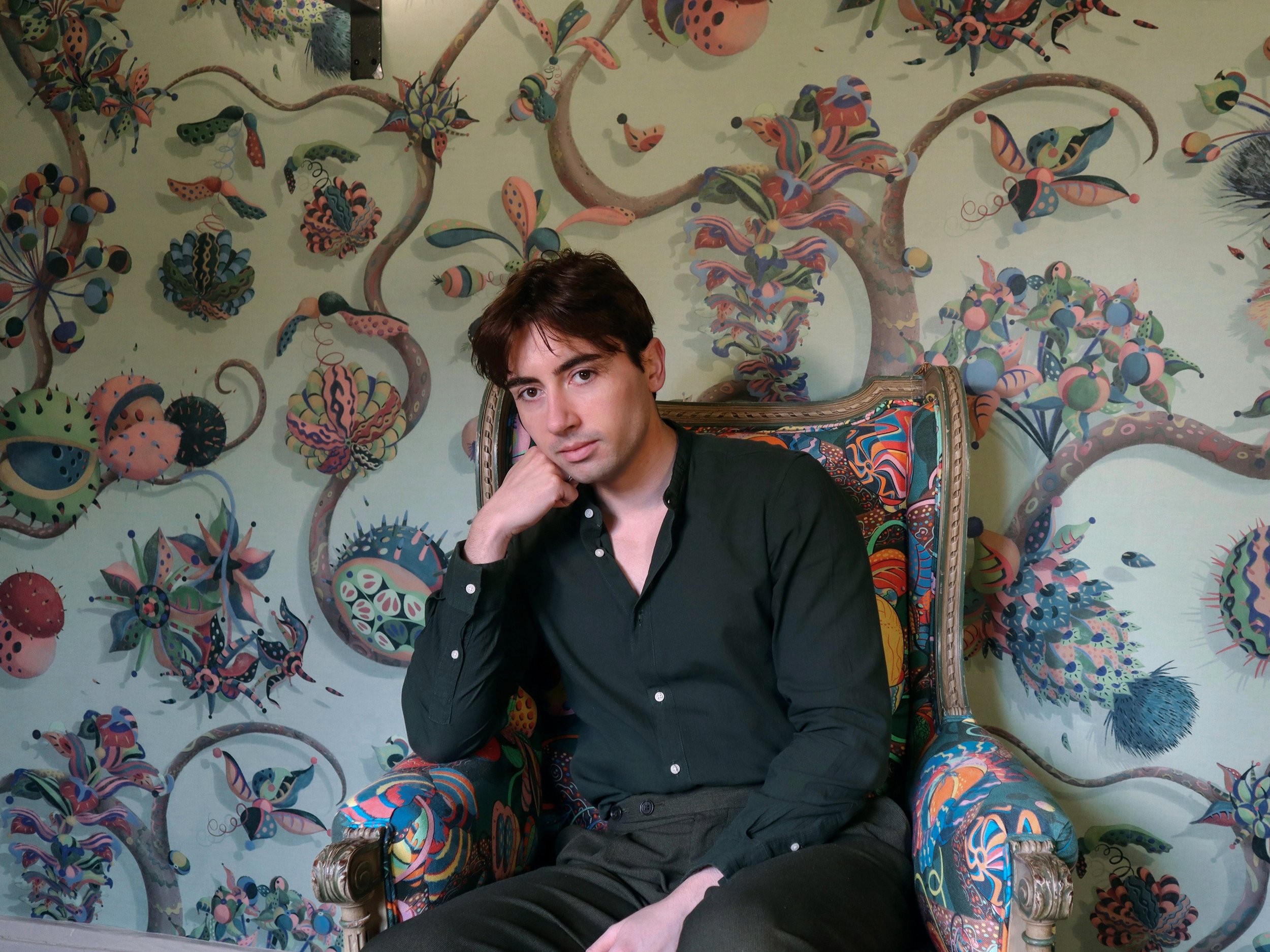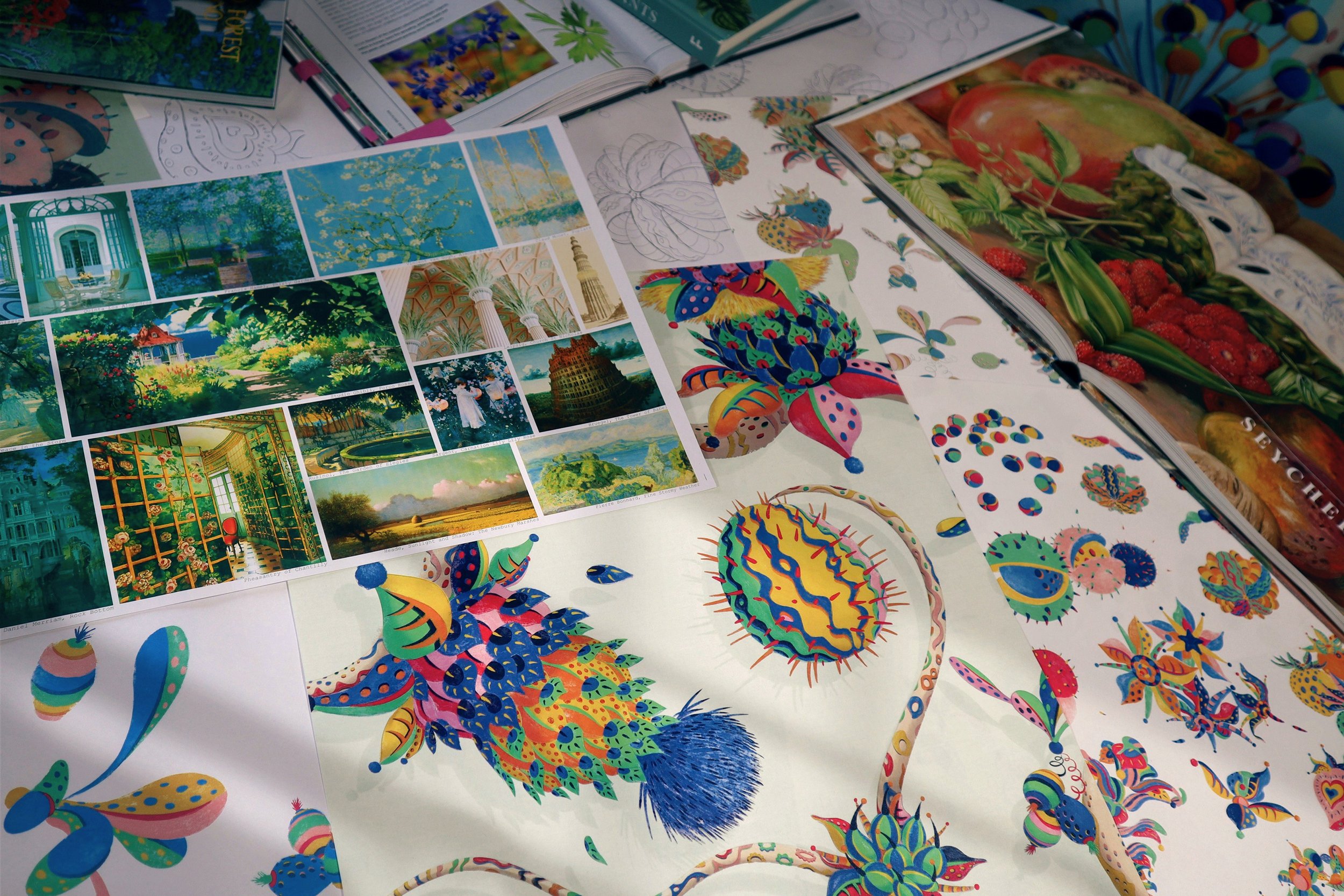Sam Wilde
Meet Sam Wilde, a British artist who creates bold, playful, and imaginative patterns. Drawing on his science background, his colorful, detailed artworks offer a fresh and surprising take on pattern design, turning them into captivating and unique worlds.
Hi Sam, how are you?
I’m in high spirits thank you and thrilled to be able to interview with Blumenhaus today. I’m big fan of the publication, both Camille and Isabelle have managed to capture something quite magical at the intersection of art and botany.
Who are you, where are you from and where are you based?
My name is Sam Wilde, I’m visual artist based in Southeast London, and I’m probably best known for blending a background in natural sciences with my colourful hand-drawn patterns.
Why did you start your own brand, Vespertine?
I think of it this way. Patterns are all around us, on our screens, clothes, public spaces, furniture, stationary, you name it. Now usually we don’t give these patterns much more than a second thought. But what if these patterns were so much more. What if we saw them as windows of opportunity? A feast for the eyes. Epic worlds we could escape into. To immerse ourselves within, to learn from, to empower us.
That’s what Vespertine is all about, a space for the patterns I’ve created to come to life. To bring my worlds into your world, to enrich our bodies, homes and places with fine art patterns depicting unabashed warmth and eccentricity.
What’s the story behind the name?
I originally started a foray into art by posting my illustrations on Tumblr back in 2014. At the time my screen name or pseudonym was Dusk Designs as all my drawing work was done in the late evenings outside of office hours. Fast forward to 2018 and as I approached graduation from the Royal College of Art, I thought it was time to evolve on that precedent.
I was mulling over biological words that might be suitable - “nocturnal” active during the night, “diurnal” active during the day… and then it hit me “vespertine” which refers to plants and animals that bloom and awaken during the evening. Instantly it felt like the perfect fit and just so rich in symbolism relevant to my creative practice.
How would you say your education in Natural Science has had an impact on your work / printed textiles?
Before I graduated with a master’s from the Royal College of Art, I did a BSc in Natural Sciences at Durham University, specialising in biology, conservation, and statistics. When my undergraduate degree was ending, I realised quickly that I needed to hit-the-ground-running and earn a living straight out the gate. Which meant I didn’t really have the downtime to pursue a career in conservation like I had originally intended. But I was still passionate about the things I had learnt in academia to do with the natural world.
The brilliant thing about biology is, the more you learn about it, the more you’ll marvel at its many wonders. This thought became the cornerstone of my creative practice. Visualising little known biological phenomena and spinning them into fantasy narratives founded on scientific truths. I wanted to share with audiences the things you wouldn’t be able to see in a David Attenborough documentary, the things that were just a bit too complex, but equally as marvellous.
For example, in a trilogy of illustrated silk scarfs I explore topics such as moth’s having evolved markings on their wings that mimic the eyes of fearsome predators with Odd Eyes. Or the inventor of taxonomy, Carl Linnaeus, dreaming up a garden where flowers from around the world would bloom with each passing hour with Flowers of Time. Or the giant living sea monster the oarfish, the world’s longest bony fish that’s able to predict natural disasters with Between Land & Sea.
It’s through these artworks that I hope to ignite a newfound understanding of the very real magic of nature in the viewer. Doing my part to inspire and solidify how beautiful this world truly is.
Would you describe your worlds as surreal?
I would say my work teeters the line between real and surreal, sitting somewhere in the middle.
I approach pattern making with the creative philosophy of weighting the worlds with a sense of reality. So that rather than drawing floating motifs for the sake of convenience. Instead, I’ll tether all the different elements within the pattern world together, so that they abide by the same laws of physics as our own world.
For example, you’ll notice how the light and shadow all go in the same direction within my patterned worlds. Despite the fact there technically wouldn’t be a singular light source. I do this as not to dip too far into a surrealist or ungrounded territory, especially as the themes themselves are already so fanciful and heightened.
Does it always involve flora and fauna?
Indeed, and as much as I try to keep the work playful, I’m also very intentional when it comes to incorporating natural motifs. I recently finished painting a new endlessly branching tree wallpaper titled Poison Panacea, which depicts a Tree of Life that grows real-world flora native to the Mediterranean region.
Here I’ve incorporated species such as the wild strawberry, bear’s breech and starflower which have healing and medicinal properties, whereas others like the European Spindle, cocklebur and squirting cucumber have toxic and even lethal properties.
I especially enjoyed adding in deadly nightshade, its Latin name Artopa Belladonna is derived from the Greek Fate Atropos who cut the thread of life, and bella donna quite literally means beautiful lady. So, a beautiful lady who cut the thread of life. Deadly nightshade raises blood pressure and inhibits nerve signals regulating heart rhythm, and in ancient times it was used as a biological weapon during warfare.
Could you tell us about your creative process?
When working on a new pattern illustration I tend to start analogue, with sketches, watercolour, gouache, and then I’ll move onto refining the seams of the repeat itself. From here I’ll translate the earlier artwork into the digital realm, trying my best to maintain the hand drawn lucidity from those beginning stages.
However, the most important part of the process of pattern creation is transforming digital into material. As this is how the viewer will experience and hopefully fall in love with the artwork. Whether that’s as a printed textile, wallpaper, installation or whatever else.
But I think what ties my broader creative practice together is my love for colour. I wrote my master’s dissertation of metamerism - which is how we perceive colour based on how visible light is refracted onto our retinas (either directly as light or as a reflection of light bouncing off a surface).
What’s your favourite natural place for inspiration and why?
This will sound like a juxtaposition, but I love to draw inspiration from heavily industrialised areas like Canvey Island. It’s an often overlooked but beautiful seaside town just outside of East London that became the UK’s hub for the petrochemical industry. The dark silhouettes of towering oil refineries offset against the shimmering waters of the Thames estuary, it’s all evocative and compelling. And I would encourage any visitors not only soak in the local sights, but also to show their support for the region’s local businesses.
Anything else you would like to share?
There will be no natural kingdom to speak of if we don’t do our part to conserve its majesty for future generations to come. For this reason, I started the #BIOappropriation initiative. Which takes the philosophy behind cultural appropriation and applies those same principles to the natural world.
Put simply, if brands have profited in any way from inspiration they’ve gained from the natural world, then it’s only right to re-invest a portion of those proceeds back into the protection and growth of those biological environments. This way the natural world can sustainably be used as a resource and reference for future generations to come.
Whether that’s illustrations of tropical palm leaves used on a patterned shirt or engineering a bullet train to mimic the aerodynamic properties of a kingfisher’s beak. The money generated from those ventures is in part due to imagery, ideas and concepts the creator has taken from the natural world. As without those biological inspirations there would be no final product to bring to market and no profit to speak of.
Sam Wilde - @vespertine
Portfolio - www.samwilde.uk
Shop - www.vespertine.uk













